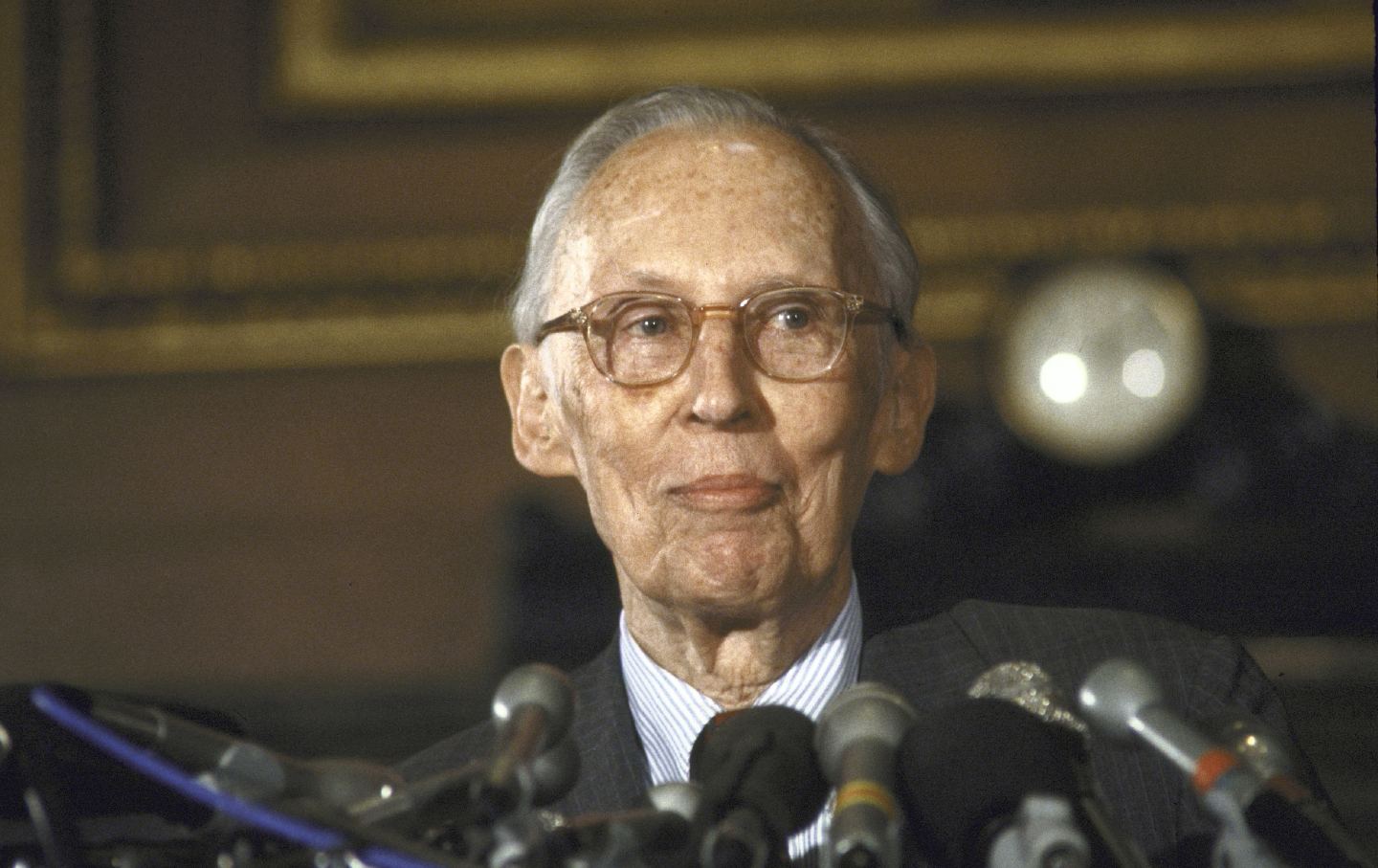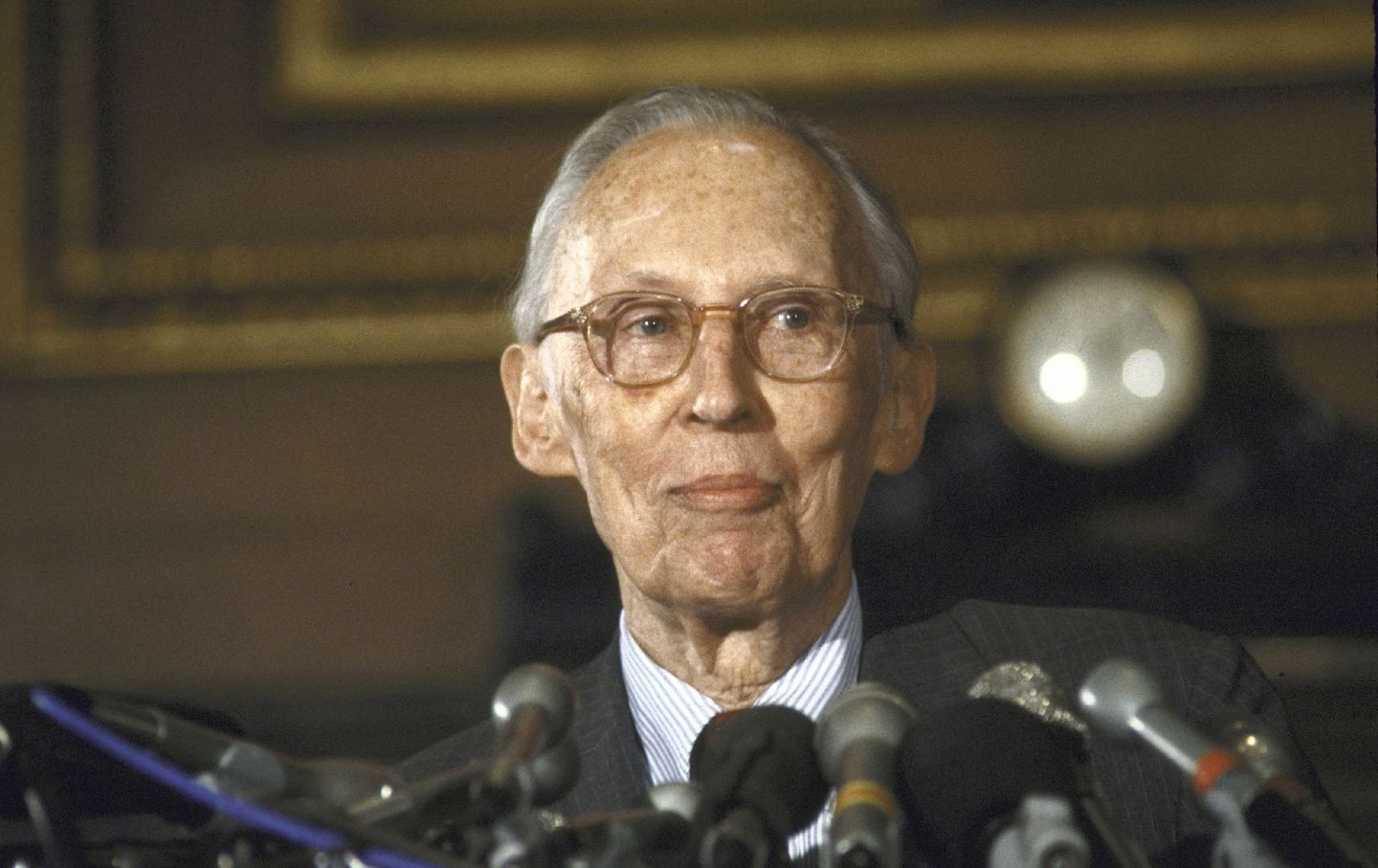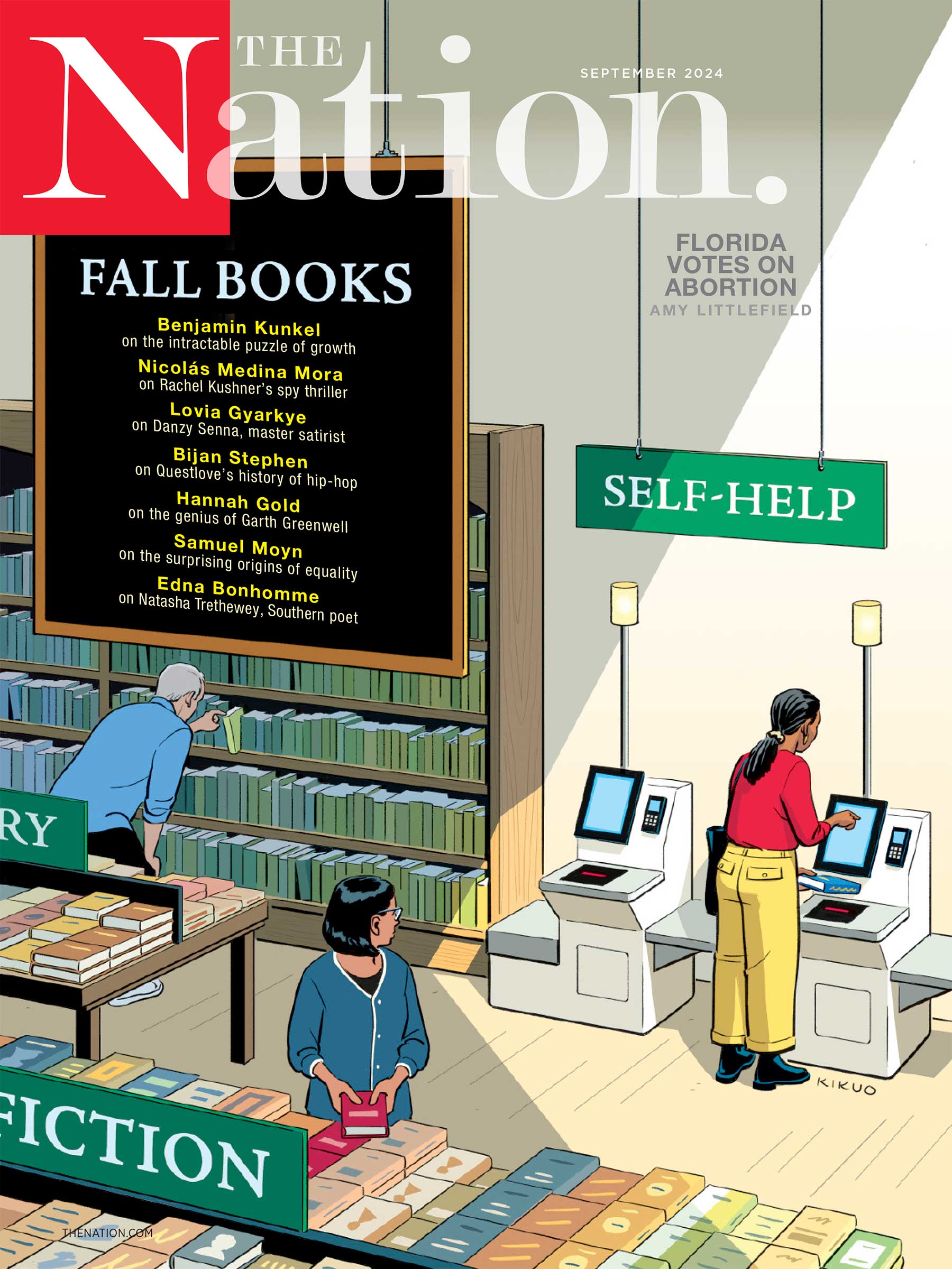
[ad_1]
September 6, 2024
A new investigative podcast shows the toxic legacy of the founding father of modern American plutocracy.

When Supreme Court Justice Lewis Powell died in 1998, The New York Times’ obituary hailed him as a judge “who brought a voice of moderation and civility to an increasingly polarized Court during his 15-year tenure.” The newspaper added, “He was the balancer and compromiser, a political moderate with an aversion to heated rhetoric and doctrinal rigidity.”
As so often, the Times was distilling the elite consensus, a view that had an element of truth only if one accepted a very narrow meaning of “moderation.” Powell’s reputation as an avatar of middle-of-the-road sanity rested largely on his social liberalism. Powell joined the Supreme Court in 1972 after a long career as one of the nation’s top corporate lawyers, known particularly for his long association with the tobacco company Philip Morris. Powell’s reputation for moderation rested largely on his personal style as an old-school Southern gentleman and his liberalism on social matters. He was part of the 7-2 majority that affirmed a constitutional right to abortion in Roe v. Wade and helped protect affirmative action in Regents of the University of California v. Bakke (1978). Both decisions have been overturned by subsequent right-wing courts.
Powell also benefited from the contrast between his social liberalism and the increasingly strident conservatism of more recent Republican appointees to the Supreme Court. When Powell resigned in 1987, Ronald Reagan tried to replace him with Robert Bork, a rebarbative reactionary who was seen as the antithesis of Powell. Bork’s nomination failed, but subsequent Supreme Court justices such as Clarence Thomas and Samuel Alito have made many centrist liberals nostalgic for the age of Lewis Powell.
Yet Powell’s moderation was highly selective, coming into play only on issues where the power of big business was not at stake. On economic matters—which make up the bulk of cases that come before the Supreme Court—Powell was no compromiser but an open partisan of unchecked corporate domination of society.
Part of the strength of the excellent new documentary podcast series Master Plan (created by the journalist David Sirota and his team at The Lever) is that it thoroughly debunks the bland image of Powell as a moderate and instead shows that he was one of the founding fathers of modern American plutocracy. Powell earns particular pride of place in the show because of his authorship of a notorious 1971 memo (prepared for the US Chamber of Commerce) that laid out a strategy for a corporate counterrevolution against the emerging social movements of the 1960s and early ’70s (notably the Black Power movement, environmentalism, and consumer protection). The memo was a call to arms for corporate America to use its economic power to push back against the left, with particular emphasis on the importance of gaining sway over the courts, the academy, and the media.
The Powell Memo was the Project 2025 of the Nixon era—a detailed program for establishing and entrenching right-wing power over the commanding heights of American government and society.
Current Issue

On the left, there’s been much dispute over the actual impact of the Powell Memo: Was it really the blueprint for the conservative counterrevolution against liberalism that has remade America—or just the little-read grousing of an angry corporate lawyer?
Writing in The American Prospect in 2005, policy analyst Mark Schmitt decried the “myth” that the memo was influential. Schmitt claimed: “The memo was circulated within Chamber of Commerce circles and became public after Powell’s confirmation to the court, when journalist Jack Anderson unearthed it to question Powell’s judicial temperament. After that, it seems to have been forgotten.”
To its credit, Master Plan forthrightly addresses Schmitt’s reasonable argument, and uses fresh investigative reporting to document that the Powell Memo, far from having been “forgotten” after Jack Anderson’s reporting, was in fact the seedbed for high-level right-wing organizing that undergirds the conservative counterrevolution.
To illuminate both the Powell Memo and its legacy, Master Plan highlights Powell’s formation during his career as a corporate lawyer. He was no mere legal-gun-for-hire for Philip Morris but a full-fledged wartime consigliere, deeply involved in strategizing the firm’s long campaign of disinformation to discredit the science proving that smoking causes cancer. This campaign included pioneering the creation of astroturf groups that both lied about the science and pretended to be independent grassroots voices—a technique later picked up by fossil fuel firms promoting climate change denial.
This opposition to mainstream medical science grew out of a belief that nothing should stand in the way of corporate profit, certainly not any concern for the health of individuals or collective concern for environmental costs. Part of the spark for the Powell Memo was Powell’s anger that consumer advocate Ralph Nader was becoming a popular hero, subject to glowing profiles even in pro-business journals such as Fortune.
This pro-capitalist attitude went hand-in-hand with rabid anti-communism and a willingness to attack any radical movement as subversive. During his years as a corporate lawyer, Powell was a close confidant of FBI director J. Edgar Hoover and an informant to the FBI. The Powell Memo compares the Black Panther Party and New Left groups to Nazis.
The Powell Memo was written at a time when corporate America felt under siege by the rising demands of new social movements. It helped galvanize the counterrevolutionary reaction to progressive politics that encompassed not just Midwestern manufacturers and petite bourgeoisie (who had long formed the backbone of the American right) but also new allies among country club Republicans and corporate America (in other words, the sort of people Powell worked with at Philip Morris). These groups had been at odds since the start of the Cold War—which divided the isolationists from the internationalists—but the Powell Memo figured out a way to unite them against a common enemy.
The Powell Memo offered the business world an approach to politics that Powell had already seen work in Philip Morris’s campaign against medical science: a flexing of lobbying power through astroturf groups and a two-fisted opposition to any attempt to limit corporate spending in politics.
Ad Policy
Master Plan opens with a remarkable scene that took place after Powell was elevated to the Supreme Court. Philip Morris threw a lavish party, hiring none other than legendary CBS News anchor Walter Cronkite to emcee a show highlighting key moments in Powell’s life. Powell was also presented with a gift: a judicial gown with the Phillip Morris logo stitched on—as if he were a race car driver advertising his sponsor. There’s not much of a leap from that gown to the expensive gifts Clarence Thomas and Samuel Alito have accepted from their billionaire pals.
Far from being forgotten, the Powell Memo was an underground bestseller in business circles. The Chamber of Commerce made copies easily available in the many thousands. Readers of the memo include a veritable pantheon of right-wing donors: the Koch brothers, Richard Mellon Scaife, and Joe Coors.
In 1973, the Chamber of Commerce organized two Powell Memo Task Force meetings. One was held in Disney World and was attended by Republican House minority leader Gerald Ford (who would soon to ascend to the presidency). Other members of the task force, as David Sirota notes, “included CBS president Richard Jenks, ABC executive James Hagerty, Ad Council chairman Barton Cummings, Metromedia executive Mark Evans, Hill & Knowlton president James Cassidy, and newspaper magnate Edward Scripps II.”
Popular
“swipe left below to view more authors”Swipe →
A concurrent Powell Memo Task Force met in Dallas and featured a speech by a young television producer, Roger Ailes—later the founder of Fox News. According to a report by attendee John Howard (president of Rockford College), Ailes “outlined the power which advertisers would be able to exert upon TV programming if they were moved to do so.” Ailes advised guests on “where and how they can apply leverage and be given the tools to exert the leverage.”
In 1974, CBS president Arthur Taylor in correspondence wrote about how the Powell Memo Task Force spurred him to push journalists at this network to be friendlier to big business. Taylor wrote, “I’ve been attempting as persuasively as possible for the last year to correct the situation at CBS News with some results, but I’m afraid it’s going to take a long time.”
Given the evidence presented in Master Plan, the Powell Memo had a very clear real-world impact. It wasn’t a distant shooting star. It was a massive asteroid that smashed the earth. It provided the theoretical program for right-wing think tanks in the coming decades of ideological war, and gave corporate donors a strategy for maximizing the impact of their spending in politics. More broadly, it can be fairly seen as the inspiration for such institutions as Fox News and the Federalist Society.
From the vantage point of the present, the Powell Memo was the precursor to Project 2025. The question that should haunt us is: If the Powell Memo achieved so much, how much more might Project 2025 accomplish?
We need your support
What’s at stake this November is the future of our democracy. Yet Nation readers know the fight for justice, equity, and peace doesn’t stop in November. Change doesn’t happen overnight. We need sustained, fearless journalism to advocate for bold ideas, expose corruption, defend our democracy, secure our bodily rights, promote peace, and protect the environment.
This month, we’re calling on you to give a monthly donation to support The Nation’s independent journalism. If you’ve read this far, I know you value our journalism that speaks truth to power in a way corporate-owned media never can. The most effective way to support The Nation is by becoming a monthly donor; this will provide us with a reliable funding base.
In the coming months, our writers will be working to bring you what you need to know—from John Nichols on the election, Elie Mystal on justice and injustice, Chris Lehmann’s reporting from inside the beltway, Joan Walsh with insightful political analysis, Jeet Heer’s crackling wit, and Amy Littlefield on the front lines of the fight for abortion access. For as little as $10 a month, you can empower our dedicated writers, editors, and fact checkers to report deeply on the most critical issues of our day.
Set up a monthly recurring donation today and join the committed community of readers who make our journalism possible for the long haul. For nearly 160 years, The Nation has stood for truth and justice—can you help us thrive for 160 more?
Onwards,
Katrina vanden Heuvel
Editorial Director and Publisher, The Nation
Jeet Heer
Jeet Heer is a national affairs correspondent for The Nation and host of the weekly Nation podcast, The Time of Monsters. He also pens the monthly column “Morbid Symptoms.” The author of In Love with Art: Francoise Mouly’s Adventures in Comics with Art Spiegelman (2013) and Sweet Lechery: Reviews, Essays and Profiles (2014), Heer has written for numerous publications, including The New Yorker, The Paris Review, Virginia Quarterly Review, The American Prospect, The Guardian, The New Republic, and The Boston Globe.
More from The Nation

The NFL does not cross the police. The NFL partners with the police.
Dave Zirin

Author Malaika Jabali tells Laura Flanders why simmering frustration could even shift some Black voters in Wisconsin to Trump.
Q&A
/
Laura Flanders

A DOJ indictment charges MAGA-loyal media figures with delivering talking points furnished by Russian state media.
Chris Lehmann

Albany must embrace transformational change to bring NYC transit back on track and be ready for the challenges of tomorrow.
Zohran Mamdani and Michael Gianaris
[ad_2]